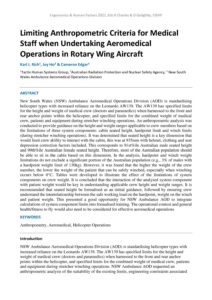| Document | Author Karl J. Rich, Joy Ho & Cameron Edgar |
| Abstract New South Wales (NSW) Ambulance Aeromedical Operations Division (AOD) is standardising helicopter types with increased reliance on the Leonardo AW139. The AW139 has specified limits for the height and weight of medical crew (doctors and paramedics) when harnessed to the front and rear anchor points within the helicopter, and specified limits for the combined weight of medical crew, patients and equipment during stretcher winching operations. An anthropometric analysis was conducted to provide guidance on the height and weight ranges applicable to crew members based on the limitations of three system components: cabin seated height, hardpoint limit and winch limits (during stretcher winching operations). It was determined that seated height is a key dimension that would limit crew ability to interact with the cabin, this was at 935mm with helmet, clothing and seat depression correction factors included. This corresponds to 91st%ile Australian male seated height and 99th%ile Australian female seated height. Therefore, most of the Australian population should be able to sit in the cabin based on this dimension. In the analysis, hardpoint and winch weight limitations do not exclude a significant portion of the Australian population (e.g., 3% of males with a hardpoint weight limit of 130kg). However, it was found that the higher the weight of the crew member, the lower the weight of the patient that can be safely winched, especially when winching occurs below 0°C. Tables were developed to illustrate the effect of the limitations of system components on crew weight. It is concluded that the interaction of the analysed system component with patient weight would be key in understanding applicable crew height and weight ranges. It is recommended that seated height be formalised as an initial guidance, followed by ensuring crew understand the interrelationship between the safe working load on the hardpoint, weight on the winch and patient weight. This presented a good opportunity for NSW Ambulance AOD to integrate calculations of system component limits into formalised training. The operational context and general health/fitness to fly would also need to be considered for effective aeromedical operations. |

